
Entomology is the scientific study of insects, a branch of zoology. In the past the term "insect" was less specific, and historically the definition of entomology would also include the study of animals in other arthropod groups, such as arachnids, myriapods, and crustaceans. This wider meaning may still be encountered in informal use.

Schinia, commonly called flower moths, is a large genus of moths belonging to the family Noctuidae. The genus has a Holarctic distribution with the vast majority of species being found in North America, many with a very restricted range and larval food plant.
Mimoschinia is a genus of moths of the family Crambidae. It contains only one species, Mimoschinia rufofascialis, the rufous-banded pyralid moth or barberpole caterpillar, which is found in the Caribbean, from Alberta to British Columbia, south to Texas and California and in Mexico.

Drasteria adumbrata, the shadowy arches, is a moth of the family Erebidae. The species was first described by Hans Hermann Behr in 1870. It is found from coast to coast in southern Canada, south in the west to California and Colorado, south in the east to New England and Michigan. Subspecies D. a. alleni is found from eastern Alberta to New York and Nova Scotia. Subspecies D. a. saxea occurs from southern British Columbia and south-west Alberta south to California and Colorado.
Euxoa aequalis is a moth of the family Noctuidae first described by Leon F. Harvey in 1876. It is found in Canada from British Columbia, Alberta, Saskatchewan and Yukon, south into the United States, where it has been recorded from Colorado, Wyoming and California.

Euxoa brevipennis is a moth of the family Noctuidae first described by Smith in 1888. In Canada, it is found in British Columbia, Alberta and Saskatchewan. In the United States, it has been recorded from Utah, Colorado and California.

Euxoa comosa, the hairy euxoa moth, is a moth of the family Noctuidae first described by Herbert Knowles Morrison in 1876. It is found in western North America, except the Pacific coast, ranging east through the northern Great Plains, and in the Hudsonian zone to the Atlantic Ocean. It is found in every province and territory of Canada, except Nunavut.
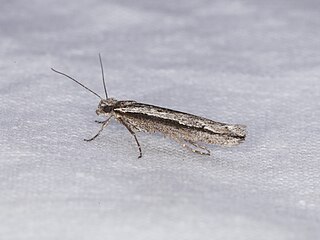
Ypsolopha flavistrigella is a moth of the family Ypsolophidae first described by August Busck in 1906. It was known only from the southern part of the United States, but has also been recorded from Alberta, Canada.
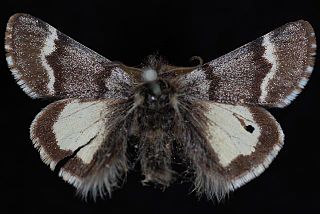
Leucobrephos brephoides, the scarce infant moth, is a moth of the family Geometridae. The species was first described by Francis Walker in 1857. It is found in North America from Yukon to Labrador and south to New York and southern Alberta and British Columbia. The habitat consists of open mixed wood forests of the boreal and mountain region.
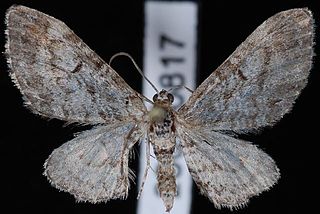
Eupithecia graefi, or Graef's pug, is a moth in the family Geometridae. The species was first described by George Duryea Hulst in 1896. It is found in North America from south-western Alberta west to Vancouver Island, north to Alaska and south to California. The habitat consists of wooded areas.
Crambidia impura is a moth of the family Erebidae. It was described by William Barnes and James Halliday McDunnough in 1913. There are two disjunct populations. It has been recorded from southern Rocky Mountain states, the Yukon and northern British Columbia and Alberta. The habitat consists of stabilized sand dunes dominated by open jack pine forests.
Spilosoma dubia, the dubious tiger moth, is a moth in the family Erebidae. It was described by Francis Walker in 1855. It is found from south-eastern Canada west to Alberta and in the eastern United States. The habitat consists of aspen parkland and southern boreal forests.
Archepandemis coniferana is a species of moth of the family Tortricidae first described by Akira Mutuura in 1978. It is found in North America, where it has been recorded from Alberta, British Columbia and California. The habitat consists of coniferous forests.
Archips dissitanus, the boldly-marked archips moth, is a species of moth of the family Tortricidae. It is found in North America, where it has been recorded from Alberta to Nova Scotia and south to Minnesota and North Carolina in the Appalachian Mountains. The habitat consists of boreal forests.

Pyrausta subsequalis, also known as the weedfield sable, is a moth in the family Crambidae. It was described by Achille Guenée in 1854. It is found in much of North America, where it has been recorded from southern Alberta and southern British Columbia south to Arizona and New Mexico and east to Florida and north to Ontario. The habitat consists of dry prairie areas.
Loxostegopsis curialis is a moth in the family Crambidae. It was described by William Barnes and James Halliday McDunnough in 1918. It is found in North America, where it has been recorded from California, New Mexico, Texas and Utah.
Loxostegopsis emigralis is a moth in the family Crambidae. It was described by William Barnes and James Halliday McDunnough in 1918. It is found in North America, where it has been recorded from Arizona and Texas.
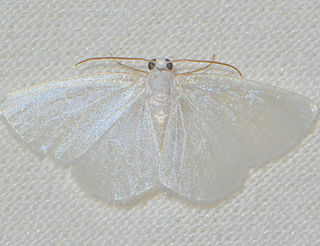
Lomographa vestaliata, the white spring moth, is a moth in the family Geometridae. The species was first described by Achille Guenée in 1857. It is found in North America, where it has been recorded from Newfoundland west to south-eastern British Columbia and south to Florida and Texas. The habitat consists of xeric shrubby edges and woodlands.
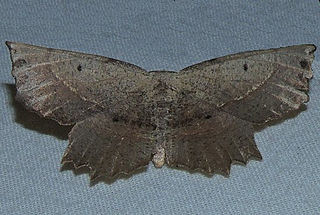
Euchlaena obtusaria, the obtuse euchlaena moth, is a moth of the family Geometridae. The species was first described by Jacob Hübner in 1813. It is found in North America, where it has been recorded from Alberta east to Nova Scotia, south to Florida and Texas. The habitat consists of mixed wood forests.

Steniini is a tribe of the species-rich subfamily Spilomelinae in the pyraloid moth family Crambidae. The tribe was erected by Achille Guenée in 1854.











